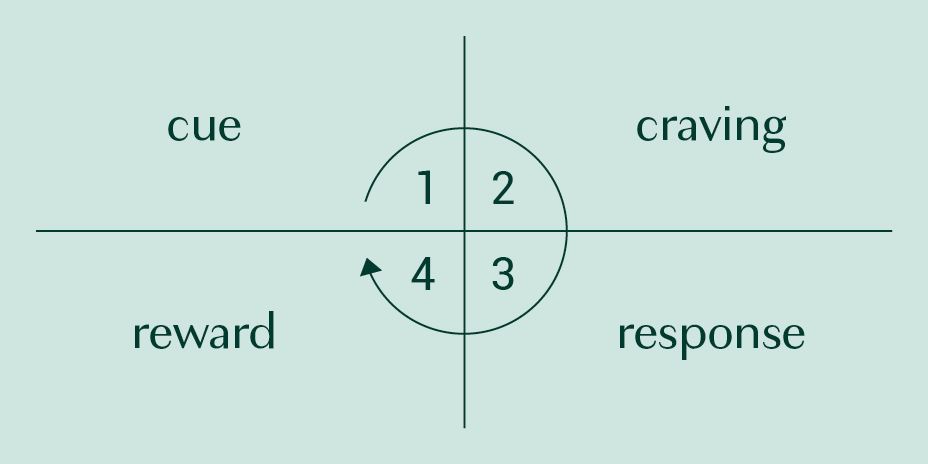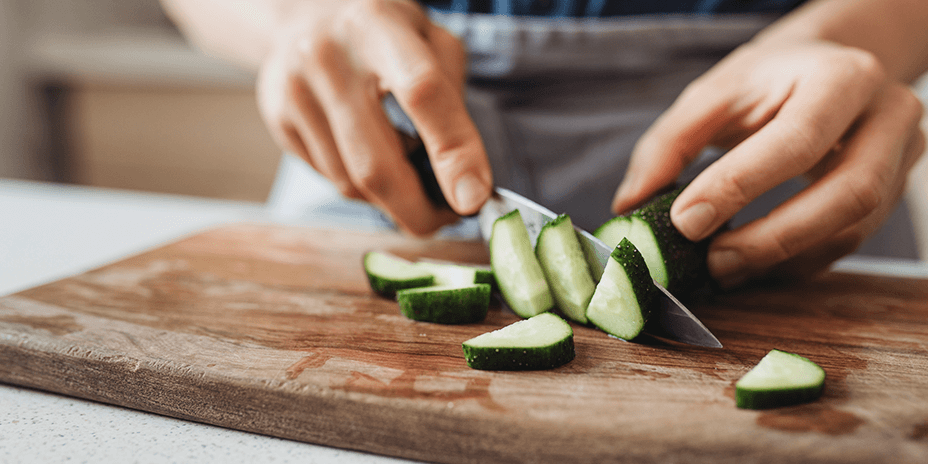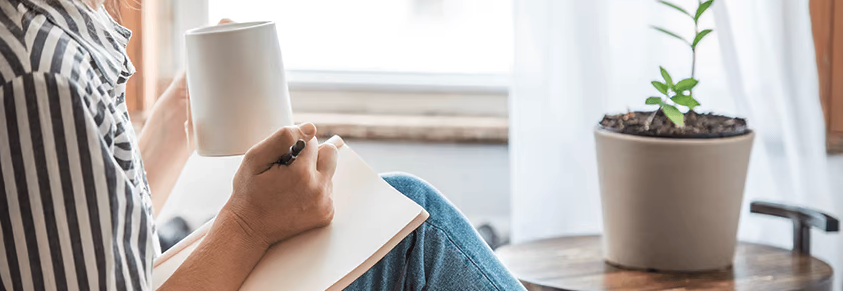Do you have a healthy habit you’d love to start, but you’re not sure how to stick with it?
If you answered “yes,” you’re about to discover how to form new, bone-healthy habits, as well as break bad ones.
The Structure of Habits
According to the book Atomic Habits by James Clear, there are four stages to a habit. And at first they happen so fast they’re almost impossible to pick up on—until you discover what they are and start to slow down and look for them.
The stages of a habit, in the order they happen, are:
- Cue
- Craving
- Response
- Reward
The CUE is what triggers the habit.
For example, an empty moment in time. Or seeing the refrigerator.
CRAVING is the feeling that comes next, after the cue triggers the habit.
The empty moment in time might cause you to feel bored or uncomfortable, resulting in a sense of wanting to fill the moment. Or seeing the refrigerator causes a feeling of wanting to snack (even if you’re not hungry, because snacks taste good).
Next, the RESPONSE is the action that results from the craving.
So, because you want to relieve the feeling of boredom or satisfy the snack craving, you open the fridge and grab some junk food. (Yes, many people eat out of boredom rather than hunger.)
Finally, the REWARD is the feeling you get from the action (response) you just took.
This is the in-the-moment enjoyment of the dopamine rush that comes from eating the snack.
That’s how a habit works, step by step.
Now let’s put the steps together and look at that example habit in full.

You see the refrigerator (the cue) which triggers a feeling of wanting to snack (the craving). In either case, you respond by opening the fridge, grabbing some junk food, and eating it (the response), which causes your taste buds to light up in enjoyment (the reward).
As you can see, a habit isn’t just one action, but rather a series of interconnected feelings and actions.
Think of one of your own habits. Can you identify these four steps at work?
So, now that you know how a habit works, let’s talk about…

The 4-Step Process for Forming a Healthy Habit
The good news is, forming a healthy habit is actually quite simple.
According to Atomic Habits, here’s how to do it:
- Make it obvious
- Make it attractive
- Make it easy
- Make it immediately satisfying
Making it obvious will help you remember to start the habit…
Making it attractive will help you want to start…
Making it easy increases the chance of you actually doing it, and…
Making it immediately satisfying will feel good, which means you’ll want to do the habit again in the future. (This is a core principle of “operant conditioning,” which is a method of learning made famous by behaviorist B.F. Skinner.2)
For clarity, let’s walk through an example.
Say you want to form the habit of walking three times a week. To help create and solidify this habit, you could do the following:
Make it obvious.
Put your walks on your calendar ahead of time so you can clearly see the exact days and times you’ve committed to exercising. Then, the evening before each walking day, take a moment to lay out your shoes in a place you’re certain to see them in the morning. Doing these things will ensure you don’t forget about your new habit.
Make it attractive.
When you see your shoes in the morning, think of how great you’ll feel after you’ve walked while you say a motivating statement aloud. Perhaps something like, “It’s time to strengthen my muscles and bones so I can stay healthy for my grandchildren.” Take a moment to visualize yourself completing the walk and feeling great about it. Allow yourself to feel the positive emotions that come with this accomplishment.
Make it easy.
Then, tell yourself that all you have to do to complete the habit for the day is put on your shoes and walk for 15 minutes. That’s it.
PRO TIP: Once you get going, you can always walk longer if you feel like it. And over time you can work up to 30-60 minutes of walking. But the point of “make it easy” is to give yourself permission to do one very tiny thing, and to know it’s enough. Making the habit very small helps you stick with it because it’s so easy to do, which removes the feeling of overwhelm and therefore makes it much more likely you’ll do the habit.
Make it immediately satisfying.
During your walk, take a moment to congratulate yourself for getting out here. Breathe in the fresh air and smile. Acknowledge that the physical movement you’re experiencing is a great thing because it’s making you stronger. Then, when you finish, take 30 seconds to intentionally celebrate your accomplishment. Maybe that’s throwing your fists in the air and saying with intensity, “I did it! This is me living my best life, and I’m proud of myself.” Take a moment to bask in your win, whatever that looks like for you.
You can use this same 4-step process to build ANY good habit you want.
So, now that you know how to form a good habit, let’s talk about…

The 4-Step Process for Breaking a Bad Habit
At this point it’s probably no surprise: to get rid of a bad habit, all you have to do is reverse the process for forming good habits!
What does that look like?
Well, you discovered above that behaviors are effortless when they are OBVIOUS, ATTRACTIVE, EASY, and SATISFYING…
Which is what you want your good habits to be.
So when it comes to bad habits you want to get rid of…
It only makes sense that the way to do that is by making them INVISIBLE, UGLY, HARD, and UNSATISFYING.
Let’s walk through an example.
Say you’ve been snacking on junk food and you want to stop.
To do that, start by making the unhealthy snacks invisible by moving them to the back of your fridge or cupboard.
Next, even though you can’t see the snacks, you’re certain to think about them at some point. When you do, make the habit of snacking ugly by reminding yourself that eating junk food is actively making you more unhealthy—the exact opposite of what you want!
To make snacking hard, you could put the snacks in a basement freezer if you have one. That way, in order to snack, you’d have to walk downstairs to get the snacks as well as thaw them. (The idea here is to put an extra step or two between the thought of snacking and the action of snacking. The inconvenience might be just enough to stop you from doing it.) Even better, get the unhealthy foods out of the house altogether—just throw them away. That way, in order to eat them, you’d have to drive to the store and buy more.
And finally, make the habit unsatisfying by asking a friend to be your accountability partner and agreeing to send them an email at the end of each day telling them either what you snacked on or, ideally, that you didn’t snack that day.
PRO TIP: If you want to snack because you’re actually hungry (rather than out of boredom), try replacing unhealthy snacks with healthy ones using the four steps you learned earlier for forming a healthy habit.
These four steps, when used together, can help you break any bad habit.
It really is that simple!
So, now that you understand the structure of habits, the 4-step process for forming a good habit, and the 4-step process for getting rid of a bad one…
It’s time for you to put your newfound knowledge into practice!
With that in mind, here are…
Your Next Steps
The habit-building and habit-removing techniques you just discovered are powerful. But they’ll only work if you put them into practice in your life.
So ask yourself…
What is ONE healthy habit I want to start doing, and how can I use the 4-step habit-building process to start doing it regularly?
Take a few minutes to write out the answer, along with your plan for making it obvious, attractive, easy, and immediately satisfying.
Then, commit to follow your plan. And, if possible, take the very first step RIGHT NOW.
Next, ask yourself…
What is ONE bad habit I want to stop doing, and how can I use the 4-step process for breaking a bad habit to stop doing it?
Write this one down too, along with your plan for making it invisible, ugly, hard, and unsatisfying.
Then, commit to following your plan. And again, if possible, take the very first step RIGHT NOW.
Did you do it?
Yes? Then congratulations! Taking action is something to be proud of.
And once you get some practice building your new good habit and breaking your old one, try using the same process for other bigger habits.
By forming good habits and breaking bad ones, your life can only get better.
Lastly, if you want to build stronger bones naturally, consider adding AlgaeCal Plus to your daily routine. The results might just amaze you.
Sources:





Felicia
March 5, 2022 , 9:58 amthank you, I printed the lesson and I will have it handy all the time I need.
Felicia